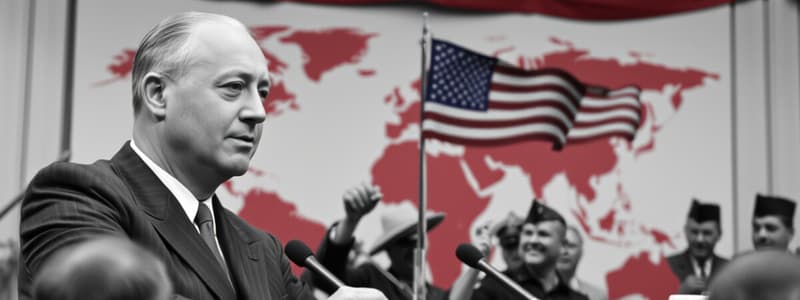Podcast
Questions and Answers
What was the primary goal of President Franklin Roosevelt's foreign policy?
What was the primary goal of President Franklin Roosevelt's foreign policy?
- To establish permanent alliances with European nations
- To engage in military conflict immediately
- To maintain strict isolation from global conflicts
- To transition from isolation to intervention (correct)
What did the Neutrality Acts of the mid-1930s restrict?
What did the Neutrality Acts of the mid-1930s restrict?
- All forms of communication with foreign countries
- Arms, loan, and trade to nations at war (correct)
- International travel for American citizens
- The ability to negotiate treaties with allies
What was the purpose of the cash-and-carry policy?
What was the purpose of the cash-and-carry policy?
- To allow the sale of arms to belligerents without restrictions
- To enable trade with warring nations if they paid cash and used non-American ships (correct)
- To offer military training to foreign nations
- To provide humanitarian aid to war-torn countries
What was the Lend-Lease Act?
What was the Lend-Lease Act?
What event prompted President Roosevelt to formally enter the United States into World War II?
What event prompted President Roosevelt to formally enter the United States into World War II?
Flashcards are hidden until you start studying
Study Notes
President Franklin Roosevelt's Foreign Policy
- Aimed to shift the United States from isolationism to interventionism.
- Initiated a cautious approach by establishing diplomatic relations with the Soviet Union and Latin America via the Good Neighbor Policy.
Neutrality Acts
- Passed in 1935, 1936, and 1937, these acts limited U.S. engagement in international conflicts.
- Established arms, loan, and trade embargoes, restricting support to nations at war.
- Allowed 'cash-and-carry' trade, permitting supply of goods to belligerents if paid in cash and transported on non-American ships.
Response to Global Crises
- Recognized the need for U.S. intervention as crises escalated in Europe and Asia.
- Supported lifting the Neutrality Acts' ban on arms to provide military aid to Britain and France.
Key Agreements and Legislation
- The 'destroyers-for-bases' deal exchanged naval vessels for rights to establish U.S. military bases on British territories.
- The Lend-Lease Act facilitated the loan of arms to American allies, bolstering their military capabilities.
- The Atlantic Charter was formed as a declaration of wartime collaboration with Britain, emphasizing shared goals.
Actions Against Japan
- Roosevelt froze Japanese assets in the U.S. and limited trade, escalating tensions with Japan.
- The attack on Pearl Harbor on December 7, 1941, prompted Roosevelt to formally enter the U.S. into World War II, finalizing the transition from isolation to intervention.
Studying That Suits You
Use AI to generate personalized quizzes and flashcards to suit your learning preferences.




